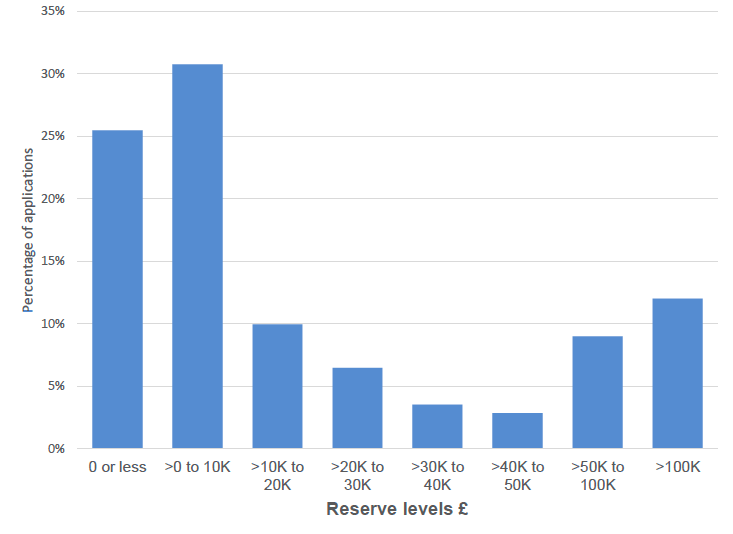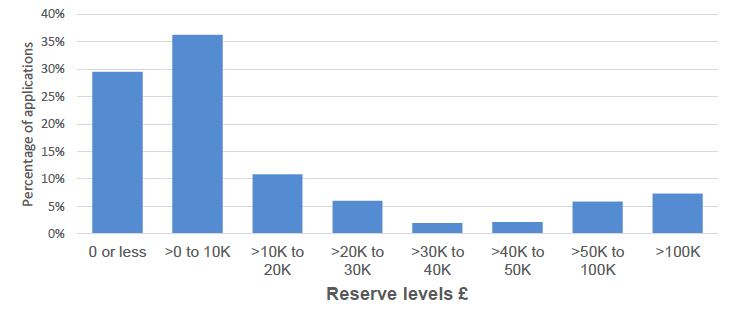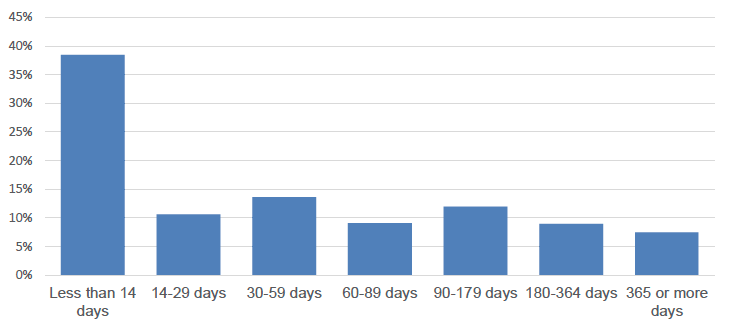Third Sector Resilience Fund (TSRF): analysis of applications and wards
Analysis of the data on applications to the Third Sector Resilience Fund (TSRF) and the awards made through the fund.
8. Financial Resilience
The TSRF application process asked organisations to submit data about their accounts and financial status. In this section, this information is used to examine the financial situation of TSOs seeking emergency funding through the TSRF by focusing on applicants' levels of reserves, and their reserve levels in relation to operating costs.[8] The quality of data is variable, as different organisations were asked to provide different financial information depending on the application route they used, and full data was not available for all organisations. This analysis therefore provides indicative findings only on the financial resilience of organisations applying for TSRF funding.
These results are not representative of the third sector more widely as organisations were not eligible for TSRF funding if their current reserves could cover more than four months (phase 1) or 12 weeks (phase 2) of operating costs. TSRF applicants were therefore organisations with lower financial resilience than the sector as a whole.
Reserve Levels of TSRF Applicants
The data show that 25 per cent of all the applicant organisations had zero reserves, and in some cases reserves were negative. Overall, 56 per cent of organisations had £10,000 or less in reserves. 12 per cent of all applicants had reserves of over £100,000.
Organisational Reserve Levels, All Applicants

The data suggest that the majority of third sector organisations represented here are operating with a minimal financial buffer.
Reserve Levels of Awarded Organisations
Of the organisations receiving awards from the fund, 70 per cent had at least some reserves. Nevertheless, the overall level of reserves among awarded organisations was low, with 30 per cent stating that they had no reserves at all, and a further 36 per cent stating that they had reserves of up to £10,000. Overall 66 per cent had reserves of £10,000 or less. Only 7 per cent of awarded organisations had reserves greater than £100,000.
Organisational Reserve Levels, Awarded Organisations

Reserves in relation to operating costs
Reserves alone are a limited indication of the financial resilience of an organisation. The above analysis of reserves does not account for the varying sizes of the TSOs applying for the TSRF, or their varying operational costs. Here, the available data on organisational expenditure/turnover is used to derive daily expenditure rates – the average cost of an operating day based on reported annual expenditure. These rates of expenditure are then compared with reported data on reserves to give an understanding of reserves in relation to operating costs.[9]
Based on the reserves data submitted by applicant organisations, 38 per cent of all applicants had reserves sufficient for less than two weeks of (notional) expenditure costs at the time of application. Almost half (49 per cent) percent of applicants had reserves sufficient for less than one month of expenditure.
Analysis conducted on the first month of applications to the fund found a similar pattern, with 37 per cent of all applicants having reserves that would meet less than two weeks of expenditure, and 47 per cent having reserves sufficient for under one month of expenditure. This suggests that the overall financial strength of TSRF applications was relatively similar across the whole life of the fund.
Number of Operating Days Remaining Based on Current Reserves, Applicant Organisations

While this picture does not take into account the levels of cash that organisations held in their accounts, it does suggest that many of the applicant organisations would have been unable to operate for more than a few days or weeks in the absence of their normal income stream, and that the TSRF may have played an essential role in helping organisations to remain operational.
Contact
Email: socialresearch@gov.scot
There is a problem
Thanks for your feedback